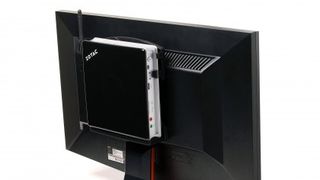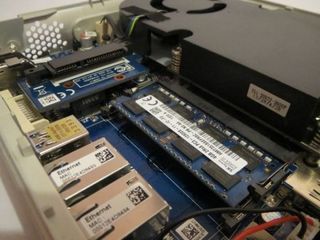TechRadar Verdict
Small, upgradable and quiet, there's a lot to recommend the Zbox; but it's let down by a slow drive and there are rivals snapping at its heels.
Pros
- +
Good general performance 802.11ac Wi-Fi Upgrade room Versatile chassis Quiet, cool and frugal
Cons
- -
Middling build quality Dated looks No HDMI Smaller rivals Slow hard disk
Why you can trust TechRadar
Zotac has spent the past few years churning out impressive small-form-factor computers with more consistency than any other manufacturer, and the Zbox ID92 Plus is its latest effort. At £430 inclusive of VAT, it's one of the most expensive models the firm produces, but that's for good reason – this machine includes a new Haswell processor as well as all the other components you'd expect.
The star of the show in this latest model is a Haswell chip, and we've rarely seen such powerful silicon inside such a small machine: the ID92 Plus is just 188mm from front to back and 45mm across. It fits into tiny spaces, and an included stand and VESA mount both add versatility: the former allows for vertical operation, and the latter means this PC can be attached to the back of compatible monitors.
The processor is a desktop-edition Core i5 that uses Intel's latest Haswell architecture, and there's 4GB of RAM and a 500GB hard disk. There's even a decent amount of upgrade room, with a spare memory socket and room for an mSATA SSD. The only thing that's not included is an OS so, if you want Windows, you'll need to factor that into the price.
As usual, there's an alternative Zbox ID92 available. The standard version – without the 'Plus' suffix – is a barebones system. That means you get the case, motherboard and processor, but you need to supply your own hard disk and memory. It's a cheaper option, especially if you have existing components that could be used: the barebones version costs £350, while the Plus model we've reviewed here will set you back £430.

The popularity of smaller, more efficient components means there's strong competition in the small-form-factor PC market. We've seen a host of worthy machines over the past months: the Lenovo IdeaCentre Q190 is similarly small and significantly cheaper, and the Lenovo ThinkCentre M92p Tiny is more expensive – but it's very small and has plenty of business features.
And, if the Zotac still looks too big, there's the Gigabyte Brix – it's just 115mm across and 30mm tall, and the new GB-BXi5H-4200 model includes a mobile-edition Core i5 Haswell processor for just £338 inc VAT. It's a barebones unit, though, so you'll have to supply your own storage, memory and operating system.
The final competitor comes from Zotac itself: the ID65 is almost as small as the Gigabyte, and now it's been updated with Haswell hardware – although the Core i7 chip used here is a mobile part.
Specifications
The processor used by Zotac in the Zbox ID92 Plus is a Core i5-4570T. It benefits from Intel's Haswell technology, which introduces several architectural improvements that give application performance, gaming and power efficiency a boost.
The 'T' suffix on this particular processor is important: that means this is a low-power part with a TDP of 35W – less than half the peak power of full-fat Haswell chips. That, inevitably, involves a little compromise: the 2.9GHz stock speed and 3.6GHz Turbo pace are lower than the top speeds of full-power CPUs, and there are only two cores rather than four – although the low-power chip inside the Zotac does, at least, have Hyper-Threading. There's 4MB of L3 cache, too – the full-fat i5-4570 has 6MB.
The Zotac's i5-4570T has the new HD Graphics 4600 integrated chipset, which is the same as the full-power i5-4570, but it's also been cut back: its minimum pace of 200MHz is 150MHz less than the main chip's base speed, although both processors share a top speed of 1,150MHz.

The Haswell Core i5 processor inside the Zotac compares well to rival machines. The Lenovo IdeaCentre Q190 remains available with slower Pentium or Core i3 processors based on older architectures, and the ThinkCentre M92p Tiny is still saddled with Ivy Bridge processors – again, older silicon.
Ironically, it's the Zotac's two smallest rivals that are closest when it comes to pace. The Gigabyte's refreshed Haswell model features a mobile-edition Core i5 with a HD Graphics 4400 chipset, and Zotac's own Zbox Nano ID67 Plus now includes mobile-edition Core i7 Haswell processors.
Elsewhere, we've no complaints about the specification. There's a 500GB Western Digital hard disk, 4GB of DDR3 memory and 802.11ac Wi-Fi – which makes this one of the first desktops to include this future-proofed connectivity standard.

It's all contained within the Zbox's comparatively small chassis – and, unlike several small-form-factor machines, Zotac positively encourages upgrades. One side of the system can be slid away by unscrewing a couple of thumbscrews, the hard disk is installed inside a caddy that's removed with another thumbscrew. The two memory slots lie beneath – the Zbox can handle a maximum of 16GB memory – with one free underneath, and there's an empty mini-PCI-Express slot that's ripe for an mSATA SSD.
The LGA 1155 processor socket sits beneath a cooler that's easy to remove, and the Wi-Fi card is also underneath inside a half-size mini-PCI-Express slot.
The outside is well-equipped, too. The front has a USB 3 port, card reader, two audio jacks and an infra-red receiver, and the back edge houses two USB 3 connections, two gigabit Ethernet ports, an optical S/PDIF jack, two DisplayPort connectors and DVI-D. There's a connector for the Wi-Fi antenna, and one side also has a fourth USB 3 socket, but no HDMI.
It's not all good news. The Zotac's plastic chassis looks dated, and build quality is mediocre: the top panel flexes a little when it's depressed, and the removable bottom panel feels even flimsier. And there's no operating system as standard, so it's either Windows for around £75 or a free Linux distribution.
Mike has worked as a technology journalist for more than a decade and has written for most of the UK’s big technology titles alongside numerous global outlets. He loves PCs, laptops and any new hardware, and covers everything from the latest business trends to high-end gaming gear.

